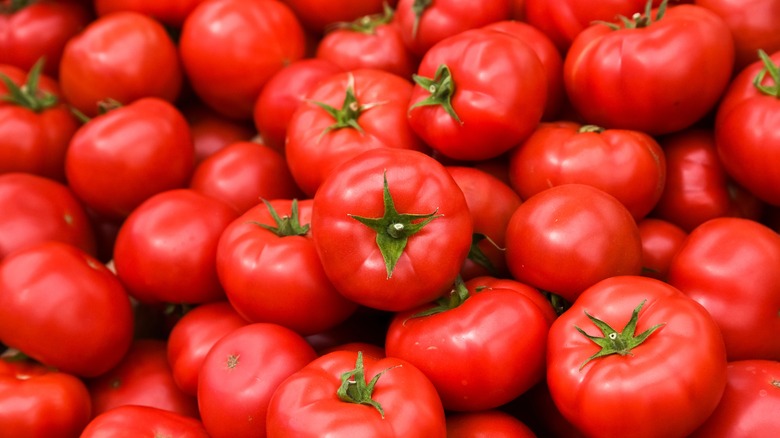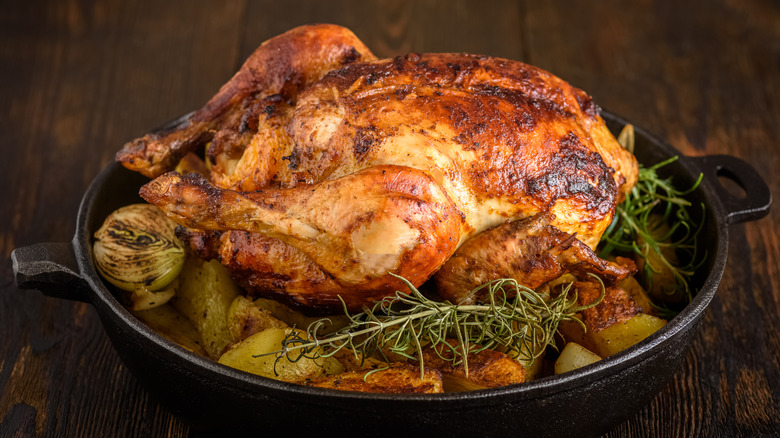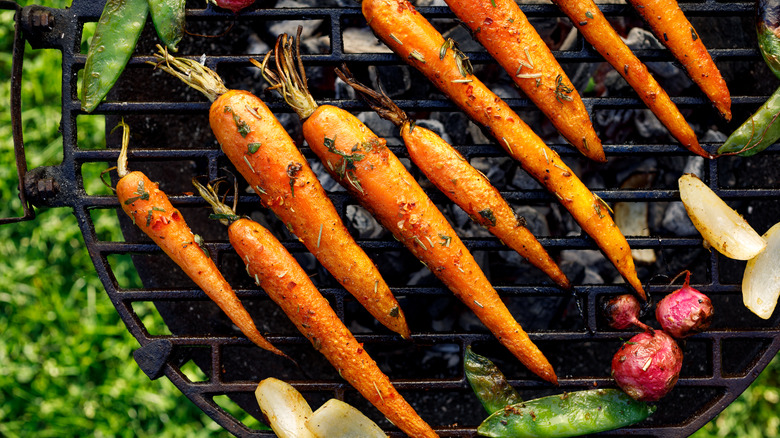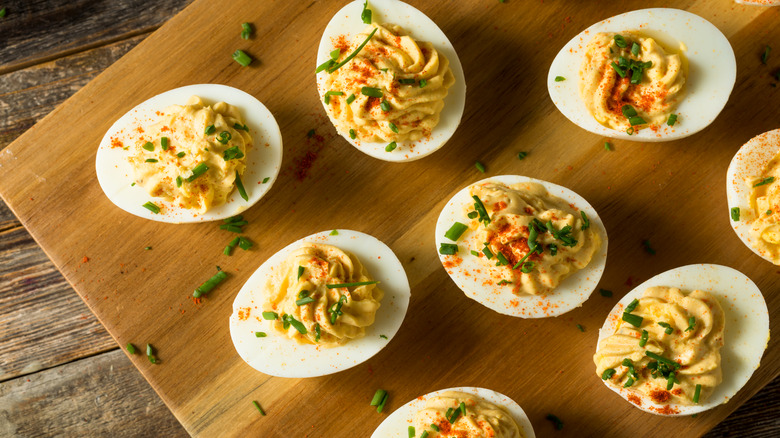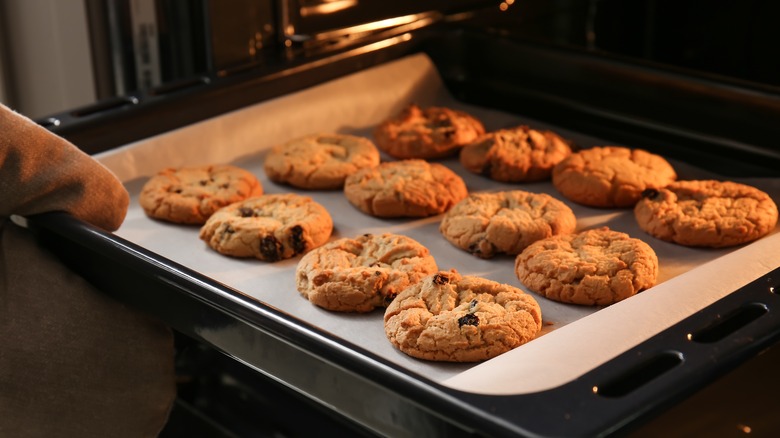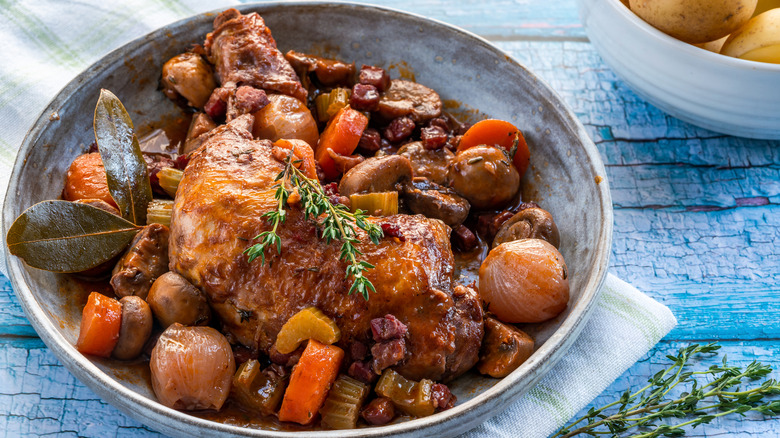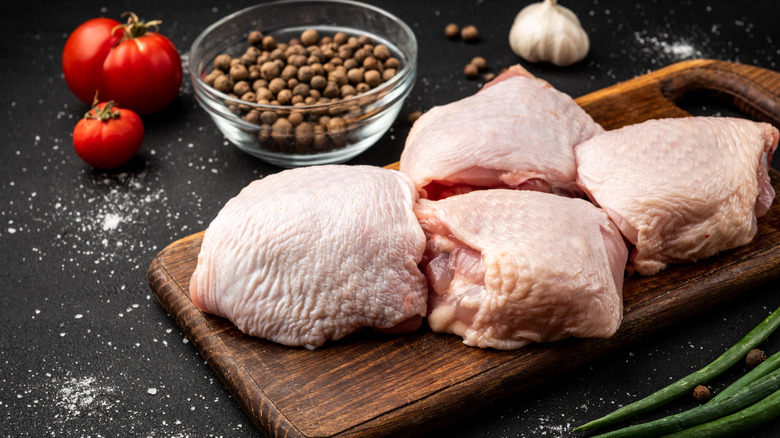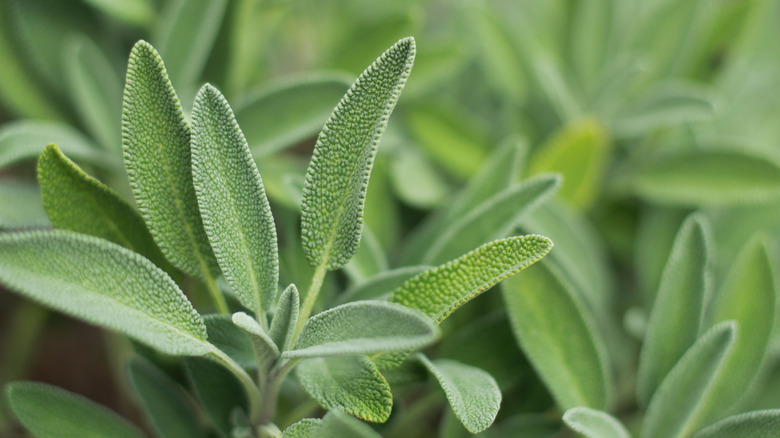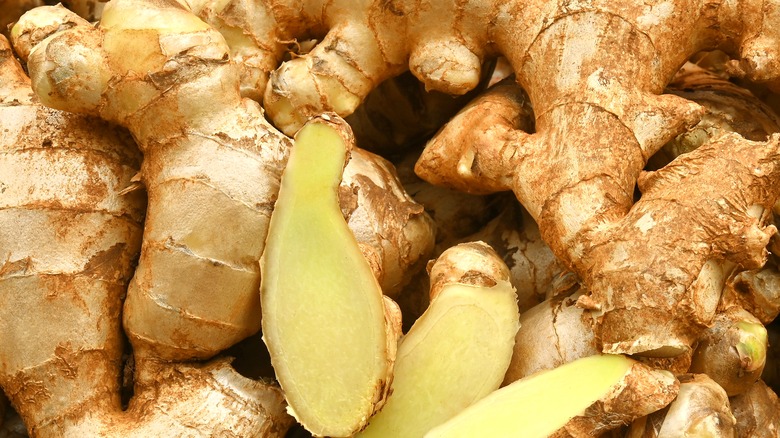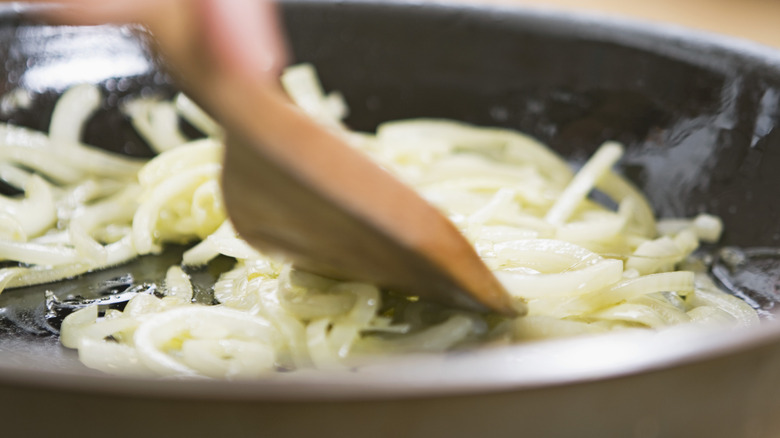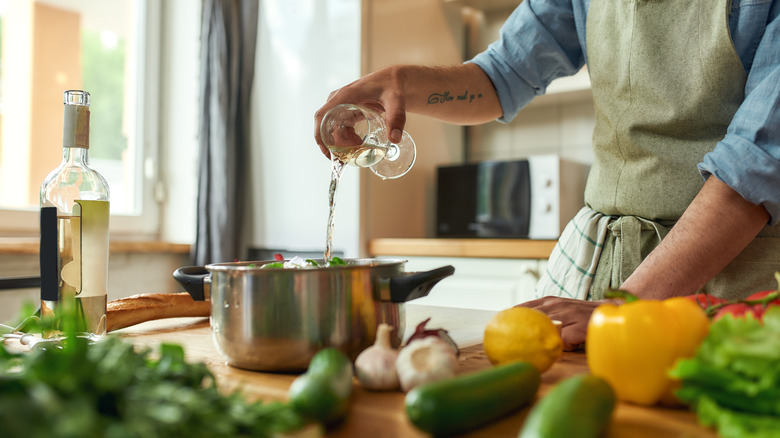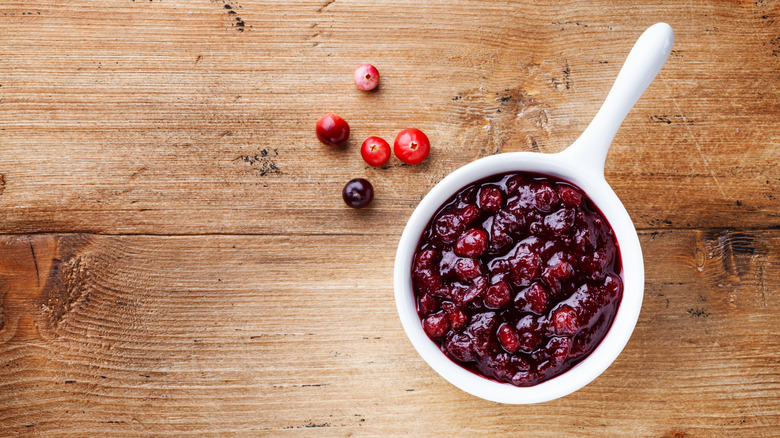The Top 15 Alex Guarnaschelli Cooking Tips You Need To Know
There are some celebrity chefs who you just trust, and Alex Guarnaschelli's one of them. The Food Network mainstay has been entertaining and educating grateful viewers for years, and brings a wealth of knowledge to her television cookery. Guarnaschelli's cooking combines delicious flavors with a resourcefulness that appeals to anyone who's ever wanted to make the most of what they have in the kitchen. According to the famed chef, this resourcefulness started in college, where she learned to make the most of her budget and cook in batches. This set off a love of cooking, and of working wisely with produce, which she shares with her audience today.
But with all of the cooking tips that are flying around on food channels, it's easy to miss some top tricks. And given that Alex Guarnaschelli's advice is often so useful, we decided that we wanted to put them together so that you could benefit from the food maestro's extensive knowledge. Let's take a look at some of her greatest tips.
1. A simple addition to cookie dough will make it even more delicious
A hot cookie enjoyed fresh out of the oven is pretty much heaven in a mouthful. But if you're working with store-bought cookie dough, things can sometimes not be as good as you'd like. Depending on the brand you buy, store-bought cookie dough can sometimes produce disappointing results and leave you wanting more.
But Alex Guarnaschelli is here to take those store-bought cookie dough packages, and turn them into a thing of beauty. Guarnaschelli recommends that upon removing your cookie dough tube from its packaging, you should place it on a plate of chopped nuts or coarse sugar (per People). Then, simply roll the log of dough around in your chosen covering, before slicing it up and popping it into the oven. Doing this will provide your cookies with increased flavor and crunch.
There's no need to stop there, either. If you want to make your store-bought cookie dough even fancier, try adding additional chocolate chips, dried fruits, or candies into the mix. You'll end up with some seriously tasty treats while avoiding the hassle of making your own dough from scratch. Win, win.
2. Flipping your tomatoes before cutting them makes them more useful
Tomatoes are among the quintessential flavors of summer. But using them to the best of their abilities can sometimes be trickier than you think. Cut your tomatoes too widely and you risk getting a huge chunk of the vegetable in your mouth, at the expense of other flavors. If you cut them too thinly, on the other hand, you barely get any tomato at all.
The aim is to cut your tomatoes so that you get the maximum taste from them, while simultaneously allowing them to incorporate with other flavors. Enter Alex Guarnaschelli's secret tip originally posted on her Instagram. All you have to do is place your tomato on its side, and slice it across its body, instead of from the top down. Slicing them this way increases their surface area, and by doing that, you give the other flavors on your plate more access to the tomato's interior. Your oils and seasonings will then work their way into the tomato flesh, and you'll end up with a juicy bite every time. Just make sure you're cutting them with a super-sharp knife, or one with serrated edges, to ensure you don't squash the fruit during its preparation.
3. Guarnaschelli's gravy requires no flour at all
We are firm believers in the fact that most foods are better with gravy. But it's also a cruel reality that making good gravy can be pretty tricky. Unless you know exactly what you're doing, gravy can often end up lumpy or chalky, thanks to the flour being used not incorporating effectively.
The good news, though, is that you can achieve smooth gravy without having to use flour at all, with Alex Guarnaschelli's flourless Thanksgiving gravy trick. Instead of using the wheat product as a thickening agent, Guarnaschelli explained on the Food Network (via Facebook) that she recommends making a mirepoix. This mixture of root vegetables is cooked until soft and the flavors are thoroughly combined. Then, Guarnaschelli adds it, alongside a little bit of her gravy base, to a food processor. She blends it all and then combines it with the rest of her gravy. The result is a super-smooth, pleasingly thick gravy which is also extra-flavorful thanks to the vegetables. And, as a bonus, it's a great way to sneak some nutrients into your kid's diet, under the guise of a delicious sauce for their Thanksgiving turkey.
4. Turning your chicken over will make it juicier
We're all culprits of doing things in a set way in the kitchen, and you might not think twice about certain decisions. Take the way you handle your roast chicken, for example. Once you take it out of the oven, you place it leg-side down on your chopping board, leave it to rest, and then slice it up. Same as everyone else, right?
Well, not Alex Guarnaschelli. And if you want some seriously juicy chicken, her life-changing chicken tip is one you need to try. When you take your bird out of the oven, flip it over, and place it top-side down. Doing this allows the juices in the chicken to spread more evenly through the breast meat, producing a far more tender piece of meat, Guarnaschelli says via Facebook. Leave it to rest for around 10-15 minutes, and then flip it over before carving.
Remember that this trick doesn't only work for chicken. Any oven-roasted bird, be it turkey, pheasant, or duck, will also benefit from being flipped breast-side down after cooking. Just make sure you're resting them for long enough to see the benefit and remember that larger birds, like turkeys, might need longer for the juices to run through.
5. Grilling vegetables like carrots? Braise them first
There's a good reason why carrots are so popular. Aside from being relatively cheap and really nutritious, they're also used in countless recipes, both sweet and savory. But carrots also shine on their own, and if you haven't tried grilling them, you're missing out. Grilled carrots allow the natural sweetness of the root vegetable to take center stage, with a smokiness from their lightly charred edges that make them pretty moreish.
But as fresh carrots are naturally quite hard and crunchy, they can be hard to cook all the way through by grilling them. Luckily, Alex Guarnaschelli's advice can save the day. As Guarnaschelli stated to a fan via Twitter, before you put your carrots on the grill, braise them for several minutes first. This will take your crunchy, dense carrots and soften them up, both on the outside and the inside. Softening their outsides means that you'll likely get a deeper sear on your carrots while cooking their insides makes them easier to bite through. As a bonus, braising them in vegetable stock with added aromatics helps to thread flavor through the vegetable, making them especially tasty.
6. If you're making deviled eggs, add whipping cream
Looking for a way to make your eggs an even better version of themselves? Try deviled eggs. With their roots in ancient Roman history, deviled eggs amp up your egg yolks by adding flavor and creaminess, delivering a delectable deviled dish.
But while deviled eggs are normally made by using mayonnaise to add a smooth texture, Alex Guarnaschelli recommends doing things a little differently. The chef never makes deviled eggs without whipping cream, she stated to Food & Wine. According to Guarnaschelli, adding whipping cream gives the egg yolks a particular creaminess, and helps to temper the other fiery flavors she throws in, which include dried ginger, mustard, and hot sauce.
Guarnaschelli also has some other ingenious tricks to make your deviled eggs next-level. One especially appealing one is to coat the bottom of your egg white in smashed potato chips. This adds a crunch factor that makes your deviled eggs a textural marvel and also gives your eggs additional flavor. Remember, too, to top your deviled eggs with some fresher elements to cut through the richness of the snack. Some sliced spring onions, chives, or chopped parsley will add a herbal element.
7. Jazz up your butter with seasonings
Improving on butter is pretty difficult. Pretty much the ultimate fat, a lot of people would be happy with a few generous pats of butter and some sliced bread as a meal in itself ... And by a lot of people, we mean us, obviously.
But if you end up buying unsalted butter, it can pay dividends to jazz it up a little, to make it even more delicious. And that's where this next Alex Guarnaschelli tip shines. Shared via an Instagram post, Guarnaschelli recommends unwrapping your butter stick and placing it whole on a wooden board. Then, simply sprinkle it with some sea salt flakes and some freshly ground pepper, and allow it to warm up a little if it's been in the fridge. This trick may seem simple, but you'd be amazed at how effective it is. The seasoning gives your butter a pop of taste, while the presentation will have your guests fighting over slices to spread on their sourdough.
"So good that people think you cooked all day," Guarnaschelli states in her caption, alongside some crying-laughing emoji faces. We're all about minimal effort and maximum impact!
8. Baking cookies low and slow will make them wider
Cooking food low and slow is a surefire way to make it better. But one area that we don't often apply this principle to is baking, which tends to stick to specific times and temperatures. Alex Guarnaschelli, though, likes to switch things up for a different result. And if you like your cookies thinner, with a larger surface area, her temperature trick is for you.
All you need to do, Guarnaschelli explained on "Good Morning America" (via YouTube), is turn your temperature down a little, and extend the cooking time by a few extra minutes. The lower temperature gives the cookie dough more time to flatten and expand, as opposed to becoming firm too quickly. Bear in mind, though, that by doing this, your cookies will end up likely a little crispier, as they'll cook through more. If you prefer your cookies to have a softer center, it's likely worth keeping the heat cranked up, and cooking them for the allotted length of time.
9. Guarnaschelli's bacon tip could save your coq au vin
Although there must be some people out there who like their bacon soft, they're likely far outnumbered by the crispy bacon enthusiasts. Unlike other meats, bacon has a knack for developing a serious crunch, which when combined with its salty flavor leads to an out-of-this-world flavor-texture combination.
But when bacon meets moisture, it can quickly become limp and soggy. So what do you do when it comes to coq au vin, the stewed chicken dish which relies so heavily on bacon to flavor it? Alex Guarnaschelli's top tip is to add it at the end, she states via Twitter. Cook the bacon as you normally would, frying it in a skillet until it crisps up. Then, set it to one side as you cook your coq au vin. Just before your coq au vin is ready to take to the table, slice up your bacon, drop it into the pan, and mix through so that the flavors combine. To make it extra bacon-flavored, retain the grease you cook the bacon in, and add it to the pot while the chicken is cooking.
10. Don't wash your chicken — pat it instead
Maintaining proper food safety is not only important for the flavor of your food but the health of you and your guests. That's why it can be tempting to sanitize all of your food items, including raw cuts of meat like chicken or beef. Contrary to some people's belief, though, washing raw chicken does not help to make it safer, and could be quite dangerous. By washing raw poultry or meat, which is largely unnecessary thanks to modern food safety standards, you increase the risk of spreading harmful bacteria around your kitchen (per the USDA).
So how do you prep your chicken for cooking? Try doing what Alex Guarnaschelli suggests. Once you've taken it out of the fridge, just pat or wipe it dry, she says in a TikTok video caption. It's recommended that you do this with a disposable item, like a paper towel, to avoid any bacteria hanging around on kitchen sponges or cloths. Once you've wiped the excess moisture away, throw your paper towel straight in the trash. Then, get your chicken cooking as quickly as possible. Guarnaschelli advocates cooking your chicken as soon as it comes out of the fridge, to avoid any potential bacterial mishaps.
11. Activate the flavor of your sage herbs
Simon & Garfunkel were onto something when they included sage alongside parsley, rosemary, and thyme in "Scarborough Fair." The herb stands alongside its siblings as a flavoring that offers warm, earthy, yet floral notes to a dish. But like all herbs, sage can sometimes lack a punch, and if you're throwing it into meals without any preparation, it can slightly waste the leaves' potential.
So stop making that cardinal sage mistake, and do what Alex Guarnaschelli does instead. Sage, she says via Twitter, should be activated before use by pan frying. "Stem them completely and gently fry them in a little hot oil in a pan until they crisp up and turn pale green," advises the celebrity chef. Then, all you need to do is sprinkle some salt on them, and they're good to use wherever you please. This can avoid your sage ending up tasting a little off or fishy, as the commenter she was replying to was struggling with. Once you've prepared your sage, it can go into a world of dishes, from turkey stuffing, to risotto, to sage-infused honey.
12. Losing time peeling ginger? Guarnaschelli has a tip for you
Almost everything about ginger is great — its fiery taste, its affordability, and the fact that it's potentially beneficial for everything from nausea to controlling blood sugar (via Healthline). But one thing that's not so great about ginger is the fact that you have to peel it. This can lead to a lot of wasted ginger as you try and slice off the exterior skin, as well as time lost.
But here's Alex Guarnaschelli's top tip for grating ginger, y'all: You don't have to peel it at all. Responding to a question about whether she peels ginger before grating it on TikTok, Guarnaschelli revealed that she grates it whole. Contrary to popular belief, ginger skin is totally edible, and as Guarnaschelli says, has a lot of taste in it, which can benefit your meal.
If you're going to grate ginger without taking the skin off, however, it's useful to use the smallest grater possible. Guarnaschelli uses a Microplane grater to ensure that her ginger is the finest it can be. This is a useful rule of thumb if you're peeling ginger, too, so that you don't end up with a huge mouthful of ginger root while eating your food.
13. Keep your onions from burning with a little water
It's likely impossible to count the number of dishes that start by cooking an onion or two, but it's safe to say that it's a lot. And it's also safe to say that unless you watch your onions carefully, they can burn fast, ruining your entire meal. So how do you stop burning your onions? All it takes is a little water, says Alex Guarnaschelli.
When you're browning your onions, all you have to do is add in a small splash of water, Guarnaschelli says in a video over on Twitter. Adding some water will diffuse the heat in your pan, and stop the onions from scorching, allowing them to steam gently instead. This can buy you a little extra time, Guarnaschelli says, which you can use to prepare your other ingredients.
As a bonus, adding a bit of water to your pan will help to incorporate any other flavors cooking with the onions. Just make sure you don't add too much, though. Go overboard even slightly, and your onions will become waterlogged and soggy. All you need is a tablespoon or two in most circumstances.
14. Too much wine in your sauce? Balance it out
We've all been guilty of a little too much wine. And no, we're not talking about that time at the office Christmas party where you ended up karaoke singing. Putting too much wine in can throw off the balance of your other ingredients, and make your dish taste substandard. As wine is acidic, you might find that your meal starts to taste a little tart.
But to fix a dish after you add too much wine, Alex Guarnaschelli recommends simply rebalancing the ingredients. The success of adding wine to food depends on its relationship with the fats used. And Guarnaschelli says that to counterbalance excess wine, simply use a little more olive oil or butter (via Food & Wine). Guarnaschelli notes that wine and oil in savory dishes are similar to vinegar and oil in salad dressings, and the best chefs understand that the two work in harmony.
If you're running low on oil, though, or feel you've already used a lot, the chef has another suggestion. Throw an onion or two in the food processor, blitz them into a purée, and then add them to your food. For savory dishes, this is a great way to diffuse some of the wine flavor and add some earthy notes back to your dish.
15. Cranberry sauce is better not cooked together
Without cranberry sauce, Thanksgiving dinner simply isn't complete. But rustle up a bad cranberry sauce, and that very same dinner might be complete, but pretty dissatisfying. Luckily, Alex Guarnaschelli's top tip for homemade cranberry sauce will save the day. In a helpful video on TikTok, the "Chopped" judge states that she first cooks her cranberries with the other ingredients for roughly 10-12 minutes. She then strains the berries out and simmers the liquid until it thickens up.
Once the liquid reduces sufficiently, Guarnaschelli then puts the cranberries back in, mixes it all together, and then takes the whole thing off the heat. By doing this, your cranberries remain firm and plump and don't completely disintegrate into your sauce. It's important to remember, though, that how you like your cranberry sauce is a personal preference. So, if you prefer things to be slightly mushier, cook your cranberries in the sauce for a few minutes longer before chilling. Remember, too, that sugar isn't the only component of cranberry sauce to amp up its taste. Guarnaschelli also throws in cinnamon, allspice, and nutmeg to make her sauce taste just like the holidays.


